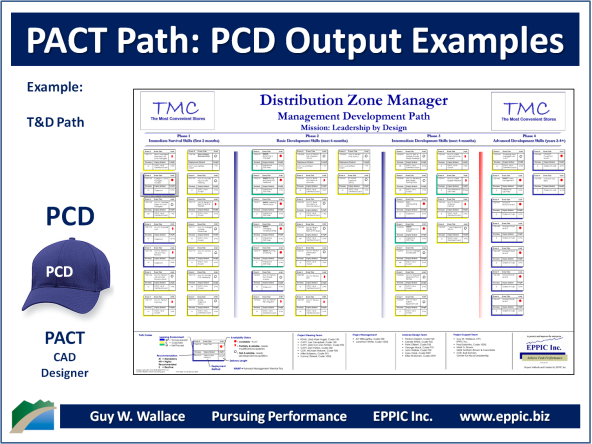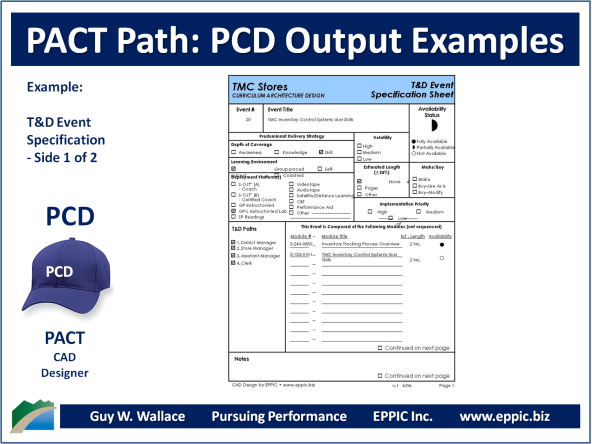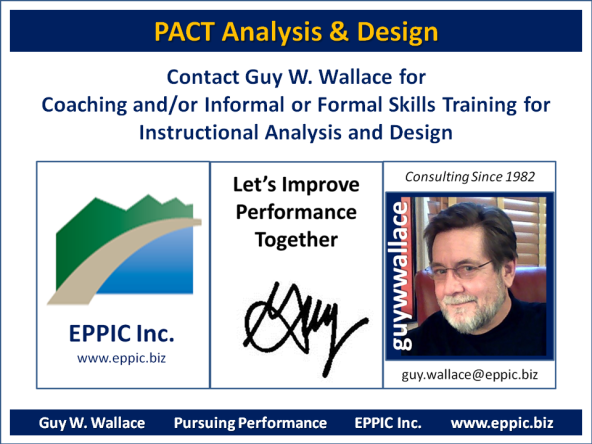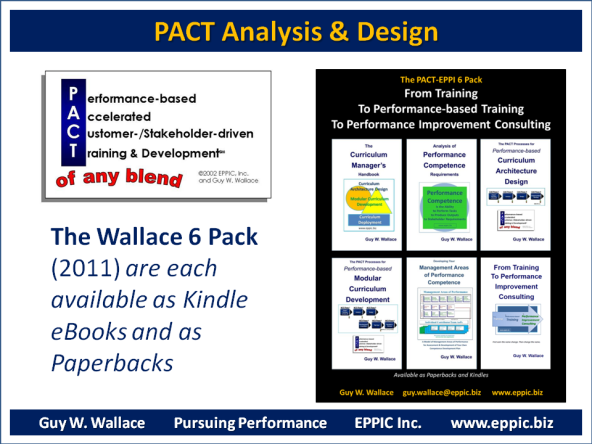Note: This page is basically complete – as of 2018-05-22 – but will continue to be Updated from time to time. Last Update: 2018-05-22.
PACT Practitioner Role Overview
The PACT CAD Designer is responsible for preparing and conducting/facilitating the Group Process for the Design Team Meeting in a Curriculum Architecture Design – CAD effort and then to process all of the analysis data in a 7-Step Design process for creating a modular T&D/L&D Path, and creating “Specifications” for all gaps at two levels: Events and Modules.
The PACT CAD Designer either produces the CAD Design Document or assists the Project Planner/Manager in producing it.
List of Task Responsibilities to Master
The PACT CAD Designer is responsible for the following tasks:
- Reviewing the Analysis data
- Preparing for the CAD Design Team Meeting
- Conducting the CAD Design Team Meeting
- Documenting the CAD Design Team Meeting in a CAD Design Document
- Contributing to the development of the Project Steering Team Gate Review Meeting
- Co-Presenting at the Project Steering Team Gate Review Meeting
- Updating the CAD Design Document as needed

PACT CAD Designers Perform in CAD Efforts

The PACT Processes – are owned exclusively by Guy W. Wallace – and may be used for non-commercial purposes – with appropriate attribution.
Those wishing to use these methods and templates for commercial purposes may not do so without a license agreement.
Example PCD Outputs
Note: TMC – The Most Convenient Stores – or just TMC – is one of my Case Companies used in T&D sessions for PACT Practitioners.
T&D Path or Map
This visual Development Path or Development Map provides a suggested sequence of modularized T&D Events – a sequence suggested by the Master Performers on the Curriculum Architecture Design – CAD – Design Team – and includes both OnBoarding & Immediate Survival Skills – and OnGoing development – providing Most 10 Before Most 20 Before Most 70 in a Flipped approach to 70-20-10.

This provides “visual” guidance regarding the available Performance Support and Instructional & Informational Content of the Curriculum Architecture Design’s Path – for “downselecting and re-sequencing” as needed to “Personalize” the Training to the specifics of the the job assignment and the incoming knowledge/skills from education and experience – using the next output.
The Path/Map in its initial version portrays what is needed – and both what exists already as well as what gaps exist – content-wise – for prioritization and resourcing by the Project Steering Team. What is needed but unavailable is left to Un-Structured OJT (otherwise known as Informal Learning). And some potential Content will be deliberately left as Un-Structured OJT.
T&D Individual Planning Guide
This tool is used by the Performer and her manager, team lead, peer or assigned coach/mentor – to plan and schedule T&D consistent with the Job Assignment specifics.

This Planning tool is used for “downselecting and re-sequencing” the modular Events on the Development Path/Map – as needed – to “Personalize” the Training to the specifics of the the job assignment and the incoming knowledge/skills from education and experience.
One size does not fit all.
T&D Event Spec
This documents/specifies the Gap Content of the preliminary Path – as modular T&D Events. Both “Gap & Existing Modules” are listed – showing how some Existing T&D might be ReUsed going forward.

T&D Module Spec
This documents/specifies the Gap Content of the preliminary Path’s T&D Events – at the Module level. Gap Modules – later become Lessons in MCD/IAD efforts – and are roughly designed at this point for prioritization and resourcing – and not development.
Both “Gap & Existing Content” are listed – again, showing how some Existing T&D might be ReUsed going forward.

The purpose of a Curriculum Architecture Design – CAD effort is to identify the performance-based needs of the Target Audience(s) and then both rationalize Existing Content as well as specify Gap Content for prioritization and resourcing – as the potential ROI warrants – by a Project Steering Team.
The PCD Self-Development Path
Basic Development
This level of Development is intended to get you to a point to assist the PACT Practitioner: PACT CAD Designer.
Readings in lean-ISD
Get a free PDF of lean-ISD – or get a Kindle or Paperback version – here.
- Chapters – 1-7
- The 2 Practitioner Stories in between Chapters 7 and 8
- Chapters – 8, 9, 10, 11, 12, 13, 14, 20, 21, 28
School of PACT Videos
Audio Podcasts
- Audio Podcast on PACT – PACTPodcast_Series_2007_-_1 – PACT
- Audio Podcast on CAD – PACTPodcast_Series_2007_-_2_-_CAD
- Audio Podcast on MCD – PACTPodcast_Series_2007_-_3_-_MCD
- Audio Podcast on IAD – PACTPodcast_Series_2007_-_4_-_IAD
Intermediate Development
This level of Development is intended to get you to a point to be able to conduct the Tasks of the PACT Practitioner: PACT Analyst.
Articles by Guy W. Wallace
Videos by Guy W. Wallace
- Guy W. Wallace speaking at Eli Lilly in 1995 on Curriculum Architecture Design
- Curriculum Architecture Design – Architected or Artisan Process? – February 2012
Presentations by Guy W. Wallace
- CAD – NSPI – 1985
- lean-ISD for Training – Lakewood Conf – 1998
- lean-ISD Masters Series – ISPI – 2001
- CAD – Norfolk Naval Shipyard – 2003
- CAD – CACI – 2004
- performance-based Curriculum Architecture Design
PowerPoint Shows by Guy W. Wallace
Advanced Development
This level of Development is intended to give you additional exposure to further your insights into the Role of the PACT Analyst.
Additional Articles by Guy
- Designing for the ISD Life-Cycle – ISPI PIJ – 2002
- CAD – ASTD – 2004
- Performance-based ISD – ISPI PX 12-part Series – 2007
Additional Presentations by Guy
PowerPoint Shows by Guy W. Wallace
Additional Videos by Guy
Consulting Services By Guy W. Wallace
Guy offers informal coaching and formal instruction for all of the PACT Processes Roles – as he has practiced them since 1982 – or as it needs to be adapted and integrated into his client’s ISD Processes.

Guy has been developing his clients’ staffs in these methods since 1983.
Additional Development Resources
Books for sale – including this 6 Pack.

More recent books on The PACT Processes

See all of Guy’s books at his Amazon Authors Page: https://www.amazon.com/-/e/B08JQC4C4V
The PACT Processes – are owned exclusively by Guy W. Wallace – and may be used for non-commercial purposes – with appropriate attribution.
Those wishing to use these methods and templates for commercial purposes may not do so without a license agreement.
# # #

Pingback: Free Self-Development Resources For Learning About My ISD and PI Methods | EPPIC - Pursuing Performance
Pingback: T&D: ISD Self-Development Paths Through Free Resources | EPPIC - Pursuing Performance
Pingback: T&D: 5 PACT Practitioner Self- Development Paths | EPPIC - Pursuing Performance